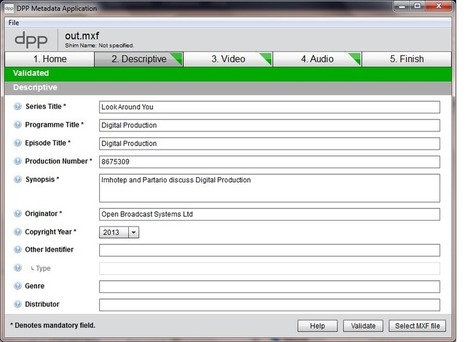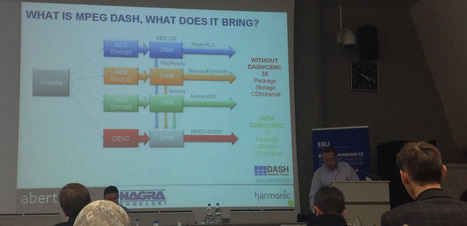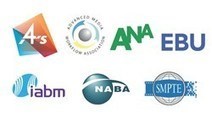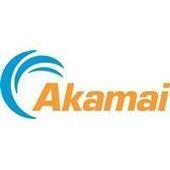 Your new post is loading...
 Your new post is loading...
The Society of Motion Picture and Television Engineers (SMPTE) on September 10 is to release a technical standard covering High Dynamic Range (HDR) images that will – in essence – match the Dolby Vision proposals from Dolby Labs.
The concept could allow viewers to see what has been described as “dazzling” in its treatment of whiter whites and permitting much more variation in representing blacks/grays and items in shadow. One commentator, The Hollywood Reporter’s Carolyn Giardina, says early demonstrations have shown that the difference is a “more noticeable upgrade compared to moving from HDTV to Ultra-HD”.
The September 10 meeting at IBC will see SMPTE publish its ‘transfer function’ document which outlines a roadmap for the technology, starting at the camera’s lens and on to colour grading and post-production and eventual delivery to broadcasters and the home.
Could MPEG-DASH be the one online video format to replace all others? In a Streaming Forum 2014 panel on the much-hyped format heavyweights includingCisco, Akamai, the BBC, and Qualcomm offered a shared hope that the industry could standardize behind DASH. “To me, it’s the young Turk,” said Kevin Murray, system architect for Cisco, comparing DASH to HLS. Broadcasters are slowly centralizing on both options, he noted. DASH, however, lacks a maturity. The format still needs ubiquity (including the ability to play on iOS devices) and integration (DASH-IF needs to act as a gatekeeper). Keep it simple, Murray advised: A unified DASH is easier to deploy and test, and offers a better user experience. Throughout the discussion, panelists balanced the need for standardization with the need to offer versions with special features. The format needs a consistency of choice or problems will show up, Murray said. “The way people do live differs,” he said, and so do the ways players support live video. Advertising video needs certain features that content video doesn’t. The solution needs a consistent framework that supports various options.
Via DASH Industry Forum
Presentation by Romain Bouqueau (GPAC Licensing) during @OVFSquad Hangout - March 2014
There is hope on the horizon. MPEG-DASH exists as an open alternative to these closed standards. Two of the three companies with proprietary closed standards have been actively involved in the formation and promotion of DASH. These efforts have been clearly successful, as DASH delivery of content is becoming more and more prevalent – for example, Netflix, Hulu and YouTube have all released versions of their content via DASH delivery. Through the efforts of Browser manufacturers, Media Source Extensions (another open standard), have become available in many browsers allowing delivery of DASH content without any additional plugins required. Unfortunately, HLS remains the most common delivery format in the US, and Apple (the author/owner of HLS) has shown no interest in supporting MSE in their browser. A tipping point is clearly on the way, which will see a massive growth in DASH delivery. Eventually Apple will be forced to embrace the current open standard, or risk losing content which has made their platform so appealing. The irony of course is that Apple has done so much marketing touting themselves as leaders of the “open web” movement, and they are the long holdout stalling the success of this open standard.
bitmovin's CIO Dr. Christian Timmerer regularly attends the standardization meetings of the Moving Picture Experts Group (MPEG). This is his report from the 106th MPEG meeting in Geneva, Switzerland ...
With free-to-air broadcasters increasingly looking to hybrid solutions, combining broadcast with IP-based advanced interactive services to stay relevant, Europe’s HbbTV standard is evolving to enable a wider range of applications. Stuart Thomson reports.
From time to time we work on other things beyond DVB broadcast encoding where Open Source can be used to transform closed broadcast workflows. The file delivery specification from the Digital Production Partnership (DPP) is one such area. However, the AVC-Intra codec used in DPP is effectively a proprietary codec with implementation in the real world being more complex than the SMPTE RP2027 that AS-11 recommends and in a number of areas implemented incorrectly. However, we have now successfully reverse engineered AVC-Intra from available samples which allows a fully open source DPP creation workflow. Along with existing Open Source projects for manipulation and creation of mxf files, a fully compliant DPP file can be delivered to UK broadcasters.
The Web standards group is going ahead with its Encrypted Media Extensions technology despite some opposition, arguing it's a step in the right direction. The World Wide Web Consortium has decided to go ahead with a technology that will let companies like Netflix stream encrypted video using Web sites -- against the wishes of the Free Software Foundation, Electronic Frontier Foundation, and 25,600 petition signatories. The Web standards group announced the move Thursday, to nobody's surprise. Entertainment-industry players had approached the group three years ago to discuss the technology, Microsoft has been helping develop it, and Google already has built the specification, called Encrypted Media Extensions (EME) into Chrome. The standard doesn't actually handle encryption and digital rights management (DRM) to govern who gets to see or copy video. Instead, it provides a standard mechanism that lets a browser call upon a plug-in that handles the work. In other words, it enables encryption but doesn't do the encryption itself.
Nothing was more welcome after day 1 of EBU BroadThinking 2013 than a good night of sleep, in order to reset the tech hype counters and make some mental room for two new sessions on broadcasters’ CDNs and the latest advances of hybrid platforms. What would be the best broadcasters’ CDN architectures today, what would be their smartest (green) evolutions, would CDN-Federation standards finally bring interop reality over hopes, what would be the most advanced deployments and future of HbbTV, how it compares with YouView in the UK : day 2 agenda was looking quite attractive – and indeed the presentations were packed with valuable informations and experience feedbacks. So here is the recap of the most interesting DAY 2 presentations and a short report on some insightful demos that were playing on the EBU floor right to the conference.
With the clearing of the patent issues that have cast a shadow over VP8's acceptability to open standards organisations as a open, royalty-free video codec, it is likely that its next major stop is becoming an MPEG standard. According to Rob Glidden, video patent analyst, Google proposed VP8 as the codec for MPEG's IVC in January. IVC is the name of one of the tracks that the ISO/IEC MPEG working group wasexploring in its search for a royalty-free codec for web video and other uses. It had been looking at technologies where the patents were expiring. But it appears that Google wanted to give the process a boost. Glidden points to a posting on the Internet Engineering Task Force mailing list from a Google WebRTC developer, where the Google/MPEG LA deal was announced, that notes: 7. Submitted VP8 to ISO SC29/WG11 (MPEG) in January of this year
for standardization.
It's all about DASH: Adoption is moving at a rapid pace, as industry insiders see a strong need to get DASH implemented in the field in the coming year. The Pantos spec, as it is known in the industry, is a series of working drafts for HLS submitted by two Apple employees as an information draft for the Internet Engineering Task Force. As of the time of this article, the Pantos spec is currently at informational version 10. Much has changed between the early versions and the most recent v10 draft, but one constant remains: HLS is based on the MPEG-2 Transport Streams (M2TS), has been in use for almost 2 decades, and is deployed widely for varied broadcast and physical media delivery solutions. In that time frame, however, little has changed for basic M2TS transport stream capabilities. For instance, M2TS still lacks an integrated solution for digital rights management (DRM). As such, all HLS versions cannot use "plain vanilla" M2TS, and even the modified M2TS used by Apple lacks timed-text or closed-captioning features found in more recent fragmented elementary stream streaming formats. Yet Apple has been making strides in addressing the shortcomings of both M2TS and the early versions of HLS: In recent drafts, the HLS informational draft allows for the use of elementary streams, which are segmented at the time of demand rather than beforehand. This use of elementary streams means that one Achilles' heel of HLS -- the need to store thousands, tens of thousands, or hundreds of thousands of small segments of long-form streaming content -- is now eliminated. Google, with its Android mobile operating system platform, has adopted HLS for Android OS 4. Some enterprising companies have even gone back and created HLS playback for earlier versions of Android OS-based devices.
|
NGCodec was at the JCT-VC/MPEG Meeting in Sapporo to help the industry to continue with the development of the HEVC standard. This was a busy meeting where we did substantial work over 9 days. JCT-VC finished the work on the 2nd version of the HEVC text covering the enhancements related to scalability (SHVC), completed the work on HEVC Test Model (HM15) software and text, the version 1 conformance and accelerated the work in relation to the coding of screen content (SCC). They were a number of additional MPEG activities that were conducted outside JCT-VC, mostly in relation to High Dynamic Range video (HDR) and royalty free codecs.
Could MPEG-DASH be the one online video format to replace all others? In a Streaming Forum 2014 panel on the much-hyped format heavyweights includingCisco, Akamai, the BBC, and Qualcomm offered a shared hope that the industry could standardize behind DASH.
“To me, it’s the young Turk,” said Kevin Murray, system architect for Cisco, comparing DASH to HLS. Broadcasters are slowly centralizing on both options, he noted. DASH, however, lacks a maturity. The format still needs ubiquity (including the ability to play on iOS devices) and integration (DASH-IF needs to act as a gatekeeper). Keep it simple, Murray advised: A unified DASH is easier to deploy and test, and offers a better user experience.
The launch of the Joint Task Force on File Formats and Media Interoperability was announced today by its sponsors, the North American Broadcasters Association (NABA), Advanced Media Workflow Association (AMWA), Society of Motion Picture and Television Engineers (SMPTE), International Association of Broadcast Manufacturers (IABM), American Association of Advertising Agencies (4A’s), and Association of National Advertisers (ANA). The European Broadcasting Union (EBU) is participating as an observer.
Bringing together manufacturers, broadcasters, advertisers, ad agencies, and industry organizations (standards bodies and trade associations) serving the professional media market, the Task Force has an ultimate goal to create greater efficiencies and cost savings for exchange of file-based content. The group’s initial focus will be to gather and analyze requirements for a machine-generated and readable file interchange and delivery specification — including standardized and common structured metadata — for the professional media industry. Use case examples include promo, spot, and program delivery from a provider to a broadcaster.
While NAB 2012 was approaching, Will Law was pushing forward MPEG-DASH on this blog as "a single [video] format that can be supported across a common ecosystem of content and services, all the way from the encoder down the chain to the end consumer" with the potential to "translate into an industry with a deeper feature set and a steeper innovation curve". What is the situation after IBC 2013? Did MPEG-DASH successfully handle this industry spread to allow a world of streamlined media workflows? Let's agree that the general perspective provided by MPEG-DASH is quite appealing for most online video professionals, with the target of drastically reducing the number of Adaptive Bitrate streaming formats to support. The recent move of Widevine dropping proprietary packaging in favor of DASH clearly goes in this direction, as well as the positive efforts of Microsoft to translate Smooth Streaming to DASH through a new generation of PlayReady DRM and new DASH-enabled player frameworks. After having recently focused on HLS support in its client implementations, Adobe now gets back to DASH with announcement of early 2014 support, which will be a major event if DASH finally comes to the huge installed basis of Flash Players and supersedes Adobe HDS format.
In this article, I am going to cover one of the most common questions in the multimedia field: what is a standard and what does it cover? Once you have read this article, you will notice how often people, even the most influential ones, use some approximate wordings. Confusion leads to a lot of misunderstanding, so it’s good to review the subject. A recurrent misinterpretation is about open-source software and open standards. In this article, I will take the AVC/H264 codec as an example. Beside the coverage of a standard, I’d like to explain how standards link one to the other. I will use the examples of MPEG-DASH and the ISOBMF/MP4 container. Then I will show what the MPEG-DASH standard is really about.
With all the excitement around HEVC and all the reports we have put out at Frost & Sullivan on the topic, we get asked all the time if MSOs should skip AVC and directly switch from MPEG-2 to HEVC. Why is this such an enticing notion and does the idea actually bear merit? To answer that question, first, some history is in order. Back in the nineties as North America transitioned to digital cable, MPEG-2 was the state of the art compression technology at the time. North America was ahead of the game even with HD and thus nearly all cable applications relied on MPEG-2 for SD and HD alike. But the industry paid a price for that early innovation – no sooner were they done with HD deployment than AVC broke onto the scene and fundamentally disrupted the video compression equation. Faced with a weak economical outlook (remember the dot com crash of 2002, anyone?), and having just made major investments in HD rollouts, the cable industry was unable to take advantage, in a meaningful way, the benefits offered by AVC. In contrast, as Europe began to transition somewhat later in the game, they did use MPEG-2 for SD digital cable but predominantly use AVC for HD. Fast forward to 2013, when the growth of North American cable subscribers slows and IPTV is surging in popularity with its vast array of content and the lure of rich applications enabled by bi-directional connectivity. The writing on the wall is clear to MSOs –they can transition their primary business to broadband services, or they must dramatically reinvent themselves and the user experience they offer to remain relevant as mainstream Pay TV service providers. Wherein lies the rub – how do MSOs meaningfully and strategically invest in infrastructure that will ensure they are at state of the art over the next decade?
In a panel discussion, Akamai considers why DASH-264 makes sense for the industry and tells the audience how to join those already working on it. DASH was a hot topic at the recent Streaming Media West conference, and one of the most-attended sessions was on the subset called DASH-264. During the talk, Will Law, Akamai's principal architect for the media division, explained why DASH-264 was beneficial. "The one positive driving people to a convergent solution is it's genuinely mutually beneficial," Law said. "It reduces the friction in your ecosystem when you're using something that is interoperable with other people in the delivery chain. So there's a natural incentive for people. It's the easier way to deploy DASH is to deploy something that a lot of other people are deploying. DASH-264 is a vehicle for doing that."
Now that virtually all major players support Apple's HLS, the shortcomings of that de facto standard may lead to more widespread implementation of MPEG-DASH.
Adobe made news several weeks ago, when it announced the impending inclusion of Apple's HTTP Live Streaming (HLS) in the Primetime player, part of Adobe's video publishing ecosystem for big media companies. Yes, we all agree, it's a big deal for HLS, both from the standpoint of players—all major players, except the standalone Flash Player without the Primetime SDK on top, now have plans to include HLS—as well as a win for Apple in creating ade facto standard out of a proprietary solution. But it may be too much too late, and could spell the beginning of the end of HLS as we know it. Wait, don't I mean too little too late? No, in this instance, I think HLS's popularity, as it is thrust out on to the global broadcast stage without yet fully putting on its costume (stabilized "recommendation" spec) may be its undoing.
The BBC has called for technology standardisation for second screen services in order to help move the the broadcast sector forwards. Speaking at TV Connect yesterday, BBC senior technologist for mobile and dual screen, Jeremy Kramskoy, said that common standards were important in terms of bringing down development and technology licensing costs. He also said that in the future connected home, when synchronisation will increasingly result in different web-powered devices talking to each other, “standardisation has to happen, otherwise it’s going to be a complete nightmare.”
Almost three years after Google released its WebM video encoding technology as a "free" and open alternative to the existing H.264 backed by Apple and others, it has admitted its position was wrong and that it would pay to license the patents WebM infringes. [...] Mozilla and Opera initially also tried to prevent the use of H.264, but have since capitulated to support H.264 as a standard, leaving Google's WebM in virtually the same position it had as a new 1.0 product three years ago, but without any excitement surrounding it. This essentially makes WebM the equivalent of Flash in 2010: resolved of legal challenges but saddled with technical and performance issues, and incompatible with any devices running iOS.
After 20 years, a next-generation digital television transmission standard is about to be unveiled. The new standard is expected to be flexible, and incorporate a wide use of spectrum, mobile technologies, 4K, 3-D and multiscreen viewing on hybrid devices that can be located anywhere.
|



 Your new post is loading...
Your new post is loading...



























